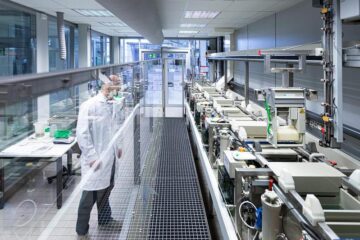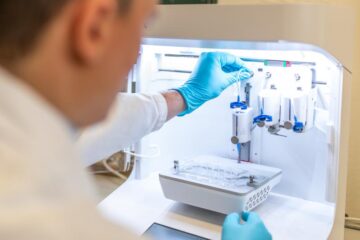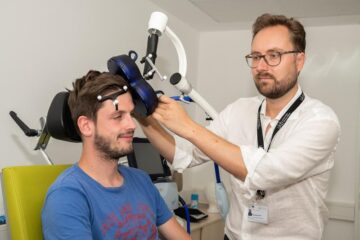Shrink-to-fit surgery

Memory could help biodegradable plastic improve stitches and implants.
Keyhole surgery might get a boost from a new shape-shifting plastic. Strong, elastic and biodegradable, it could be fashioned into thread for stitches that tighten themselves and then melt away as the body heals1.
Better still, say developers Andreas Lendlein of mnemoScience in Aachen, Germany, and Robert Langer of the Massachusetts Institute of Technology in Cambridge, USA, „large, bulky, temporary implants could be compressed and brought into the body using minimally invasive surgery and then expanded to their permanent shape on demand“.
The new plastic remembers the shape in which it was first formed. Bent or squashed into something different, it returns to its initial shape when heated.
To make their threads self-tightening, Langer and Lendlein first stretched them to up to three times their initial length. When subsequently heated to 41 oC, the threads contracted to their original length. This could pull tight a loose knot or sutures – how tight depends on how much the threads were previously stretched.
This trick, say the researchers, makes the fibres ideal for sewing incisions made during endoscopic surgery, where medical instruments are inserted and manipulated through a small cut in the skin.
Keyhole surgery minimizes scarring, speeds up healing and reduces the risk of infection. But in such a confined space, it is harder to carry out delicate manoeuvres such as stitching with just the right amount of tension. If a knot is pulled too tight, the tissues around it may die. If the suture is too loose, the incision doesn’t heal so well: scar tissue develops, which is weaker and less flexible.
Metal alloys with shape-memory have been known for some time. They are now used in dental surgery, as the ’muscles’ of some robotic devices, or in spectacle frames that regain their shape if you sit on them. Shape-memory plastics are more recent and work in a different way. Researchers at Hokkaido University in Japan reported the first one in 1995.
References
- Lendlein, A. & Langer, R. Biodegradable, elastic shape-memory polymers for potential biomedical applications. Science, published online 25 April (2002).
Media Contact
Alle Nachrichten aus der Kategorie: Medizin Gesundheit
Dieser Fachbereich fasst die Vielzahl der medizinischen Fachrichtungen aus dem Bereich der Humanmedizin zusammen.
Unter anderem finden Sie hier Berichte aus den Teilbereichen: Anästhesiologie, Anatomie, Chirurgie, Humangenetik, Hygiene und Umweltmedizin, Innere Medizin, Neurologie, Pharmakologie, Physiologie, Urologie oder Zahnmedizin.
Neueste Beiträge

Wie die Galvanotechnik durch Digitalisierung effizient wird
SurfaceTechnology GERMANY… Digitalisierung und Hartverchromung aus Chrom(III)-Elektrolyten: Das sind die beiden großen Themen, mit denen sich Forscherinnen und Forscher von der Abteilung Galvanotechnik am Fraunhofer IPA derzeit beschäftigen. Ihre Erkenntnisse…

Ersatz für Tierversuche – jetzt ganz ohne Tierleid
Erstes Gewebe-Modell der Leber völlig ohne Materialien tierischer Herkunft hergestellt. Wissenschaftler*innen der TU Berlin haben mit Hilfe von 3D-Biodruck erstmals ein Modell der Leber aus menschlichen Zellen hergestellt, ohne dabei…

Neue Wege zur mentalen Gesundheit
Magnetspule am Kopf sorgt für antidepressive Effekte… In der Klinik und Poliklinik für Psychiatrie und Psychotherapie am Universitätsklinikum Bonn (UKB) wird derzeit eine Studie zur Erforschung der antidepressiven Wirkung einer…





















